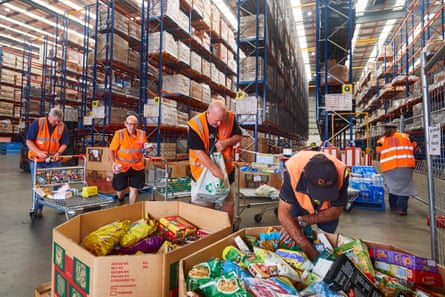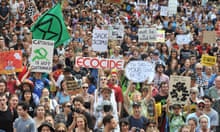Australia’s unprecedented bushfire crisis has prompted a wave of philanthropic responses globally. High-profile campaigns such as Celeste Barber’s fundraiser for New South Wales’ Rural Fire Service have raised tens of millions of dollars and celebrities incuding Chris Hemsworth (who pledged $1m to bushfire relief charities on 7 January) Kylie Minogue, Pink, Selena Gomez and Nicole Kidman have donated large individual sums.
Krystian Seibert, an industry fellow at Swinburne University’s Centre for Social Impact, notes that Australians are a generous population, ranked number four on the World Giving Index. This is particularly clear in times of crisis. “We rally around communities in need during times of natural disasters, and emergency relief is one of the top causes that are supported by Australians,” Seibert says.
This video has been removed. This could be because it launched early, our rights have expired, there was a legal issue, or for another reason.
However, donating and fundraising can be a complex endeavour. Guardian Australia spoke with Seibert, and several people running successful bushfire relief fundraisers, to find out how to make the best of our collective goodwill.
When you can, give cash
While it may feel like a nice thing to do “donating blankets and other sorts of goods can overwhelm charities”, says Seibert. Often the logistics of accepting and storing donations of goods can be too difficult for already-stretched organisations. This has become the case in Victoria, prompting premier Daniel Andrews to tweet: “It’s important to remember that the emergency relief effort is being run by experienced organisations – & they don’t have space to sort or store donations.”
I know it’s tough to watch this all unfold & feel helpless. I know a lot of people want to get stuck in & lend a hand. But it's important to remember that the emergency relief effort is being run by experienced organisations – & they don't have space to sort or store donations.
— Dan Andrews (@DanielAndrewsMP) January 5, 2020
Unless you are responding to a specific request for goods or services, “the best thing that somebody can do to help is actually donate cash”, Seibert advises.
If you’re unable to give cash but still want to assist in some way, contacting a major charitable organisation to offer your time is a good place to start. Or, if you only have an hour and some haemoglobin to spare, giving blood is always a helpful thing to do.

Be mindful of administrative burdens
When the ABC decided to turn their New Year’s Eve concert into a fundraising drive, they knew they need a partner that would be national and able to set up a phone bank to accept donations quickly. “So we put in a call to the Red Cross,” says Janet Gaeta, the concert’s executive producer. “They were amazing, fantastic to work with … This disaster and recovery fund has to be spent in Australia, it can also go to drought or flood victims in Australia.”
Gaeta knew “this is a very fine line we’re walking here … with so many people … facing utter catastrophe”. Gaeta was hopeful they would raise $1m. So far, the ABC’s partnership has raised over $10m. “The fact that we were doing it meant so much,” she says.
Seibert says that partnering with a large charity is often the best way to give: “Those appeals have the staff, expertise and linkages on the ground to understand where the funds are needed. They’re going to have the oversight.”
Direct donations keep things clean
While many first-time fundraisers “go in with the best of intentions … it can be very difficult”, Seibert notes. Working with an established partner eases that difficulty.
“Rather than set up your own … encouraging people to give to existing appeals and organisations is what I would recommend is the best approach,” says Seibert.
This is exactly the method YA novelist Emily Gale used when she and author Nova Weetman set up the donation drive #AuthorsforFireys on Twitter. Gale and Weetman are encouraging authors to use Twitter to auction signed books as well meet-and-greet opportunities. Then, auction winners donate their funds directly to Country Fire Authority Victoria. “The auction model is a little bit easier on the organisers because it takes place on Twitter and each person who’s involved auctioning an item takes care of their own auction item,” Gale says.
So far high-profile authors including Cheryl Strayed, Leigh Sales, Annabel Crabb and Benjamin Law are participating in the auction, which closes on 11 January.
Friends: I'm auctioning off 5 leather-bound copies of WILD as part of the #AuthorsForFireys campaign to support Victoria's Country Fire Authority in Australia at this time of crisis. Please follow the instructions below to place your bid. See my next tweet about the book...1/2 https://t.co/itKi2OAVpu
— Cheryl Strayed (@CherylStrayed) January 6, 2020
Okay generous people: as part of #AuthorsForFireys - @annabelcrabb and I will give:
— Leigh Sales (@leighsales) January 6, 2020
- a signed copy of Any Ordinary Day and The Wife Drought;
- 4 tickets to a @Chat10Looks3 show
- drinks with us backstage before the show.
Bid before 11pm Jan 11 via twitter@mrbenjaminlaw
My #AuthorsForFireys offer:
— Benjamin Law 羅旭能 (@mrbenjaminlaw) January 5, 2020
• Signed copy of my entire back catalogue: The Family Law, Gaysia, Moral Panic 101 and Growing Up Queer in Australia.
• Given at a yum cha lunch on me in Sydney, Brisbane or Melbourne
You can support the CFA directly here:https://t.co/hbrh6QtPUx pic.twitter.com/cUFAgOrRYl
Gale has participated in similar charity auctions in the past, but says the response to this drive is overwhelming. “I always like to donate my time, I don’t have a lot of cash to give but I do have time.”
Seibert says for individuals, Facebook’s fundraising function – which is the mechanism Celeste Barber is using – can be a very effective way to raise money for a cause. Facebook does not charge a fee for charitable donations.
If you have connections, use them
While Seibert says it’s “important to be mindful of the administrative and governance challenges associated with setting up an independent campaign”, he commends “the initiative of individuals and groups who start independent campaigns. They may identify a need that’s not being met by existing organisations, or have particular links on the ground in communities where they want to direct funds. So there is a role for independent campaigns.”
An unmet need was exactly what motivated the musician, broadcaster and community organiser Neil Morris to set up his Fire Relief Fund For First Nations Communities, which has so far raised almost $500,000.
“I’m very mindful of the impact [these fires have had] on Indigenous lives and how intense that can be,” Morris says. “There are sensitivities for our people. We do need very specific support.”
Morris notes that larger organisations may be “inundated” and “there’s only a certain amount of nuance that they can give in their support.”
Morris is working closely with communities in fire-affected areas to determine the most culturally appropriate, streamlined and useful allocation of funding. “Even for us, as First Nations people, we cannot make decisions for any community we sit outside of,” he says. He has been heartened by the sheer volume of donations his drive has received, and says: “We can’t wait for other people to come to the fore and provide what our people need. Above and beyond that, it’s our cultural responsibility to look out for one another’s people.”

You don’t have to sell something to give something
On 9 January, 30 Australian retailers including Cue, General Pants Co and The Iconic will be donating 100% of their profits to the Red Cross disaster relief and recovery plan.
Seibert says while “every bit of money helps” when it comes to companies that devote a portion of proceeds to charities and other drives, he says: “If you’re a business and you’re turning a profit, you have money that you can give, rather than expecting people to buy your products.”
Seibert suggests that, in times of disaster, businesses should not “use this as an opportunity to market your products – use it as an opportunity to show what kind of corporate citizen you are”.
He points to matched funding initiatives, where businesses can match public donations dollar for dollar as a particularly effective way of raising funds.
However, he also acknowledges “it can be tougher for small businesses – there are a few different things that they can do …even just putting a tin on the counter where people can put spare change can make a difference”.
Do your homework to avoid bad actors
In times of crisis, Seibert warns, “Certain people might prey on the generosity of individuals and there can be scams used to try and extract money from people.”
The ACCC have set up a hotline for people to report bushfire appeal-related scams, and Seibert says it is important to ask people soliciting donations on the street for more information.
While giving to established charities – such as those registered with the Australian Charities and Non-Profits Commission – is the safest way to avoid scams, donors and beneficiaries still have some protections through crowdfunding website GoFundMe, which offers a GoFundMe guarantee in cases of campaign misuse, such as intentionally misleading descriptions or funds not being delivered to their intended recipients.

Give with a thought to the future
During and in the immediate aftermath of a disaster, people are at their most generous. However, Seibert wants people to be mindful of “what happens when the bushfires subside, we move out of summer and what happens next?”
Making a positive contribution to Australia’s future is what motivated NSW Young Australian of the Year Corey Tutt to replenish the burned-down school libraries of Cobargo and Clifton Creek.
Through his organisation Deadly Science, Tutt has been providing rural and remote communities with school books, telescopes and other Stem-related equipment. “I want to be able to make sure that no kid has their education severely impacted by these fires,” he explains.
Tutt has roots in the south coast, where he used to work as an alpaca shearer, and he used those connections, particularly in the local Lions Clubs, to arrange for the delivery of books with a particular focus on texts that convey traditional knowledge, such as Young Dark Emu. Right now Tutt is acting as “a logistics octopus”, arranging for the donation of books and money, which will be deposited directly into fire-affected schools’ recovery funds.
For Seibert, it is also important that people remain mindful of the underlying causes of Australia’s current catastrophe. “What I’d be encouraging people to think about here is that in order to mitigate the impacts of climate change, which include more and more severe bushfires, there’s only so much charities can do themselves … We actually do need government action when it comes to acting on climate change.”
He warns that in recent years “there have been attacks from government on the advocacy activities and campaigning activities” of environmental organisations such as the Australian Conservation Foundation.
“Unfortunately our government isn’t doing anywhere near enough. [Environmental charities] also keep pressure on businesses to change their practices, so I think that once the bushfires do subside for summer, it’s important for people to think about how they can donate towards trying to address the systemic issues.”








